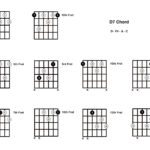The Epiphone Les Paul Junior, part of the Inspired By Gibson lineup, has generated considerable buzz among guitar players seeking an affordable and stripped-down rock machine. On paper, the specifications look impressive, promising classic Les Paul tones and feel without breaking the bank. But does the Epiphone Les Paul Junior guitar truly live up to the hype? This review dives deep into the Epiphone Les Paul Junior, drawing from both initial hands-on impressions and a long-term ownership experience to provide a comprehensive perspective.
First Look at the Epiphone Les Paul Junior Specs
The Epiphone Les Paul Junior aims for simplicity and raw power, echoing the spirit of the original Gibson model. It’s designed as a no-frills rock and roll guitar, focusing on essential features to deliver a potent sonic punch. Let’s break down the key specifications that make this guitar tick:
Key Specs Breakdown
- Body Material: Mahogany – A cornerstone of the Les Paul sound, mahogany provides warmth, sustain, and rich tonal character.
- Neck Material: Mahogany with a Vintage 50s Profile – The robust mahogany neck, shaped in a vintage 50s profile, promises a substantial feel reminiscent of classic Les Pauls.
- Pickup: P-90 PRO Dogear – The heart of the Junior’s voice, the P-90 PRO pickup is known for its raw, powerful tone, capable of both gritty crunch and surprisingly articulate cleans.
- Controls: Master Volume, Master Tone, CTS Pots – Simple and effective controls, utilizing CTS potentiometers, known for their smooth and reliable performance, allow for precise tonal shaping.
- Bridge: Lightning Bar Wrap Around – A key element of the Les Paul Junior design, the wrap-around bridge enhances sustain and contributes to the guitar’s resonant character.
- Nut: Graph Tech – An upgrade from standard nuts, the Graph Tech nut improves tuning stability and string performance, ensuring smooth playability.
- Fingerboard: Indian Laurel – A sustainable alternative to rosewood, Indian Laurel offers a similar look and feel, providing a comfortable playing surface.
These specifications suggest a guitar built for raw rock and roll, prioritizing tone and playability in a straightforward package. The inclusion of CTS pots, a Graph Tech nut, and a P-90 Probucker pickup signal a step up from budget-level components, hinting at a quality instrument despite its accessible price point.
Initial Handling and Playability
Stepping into a guitar store in 2020, the Epiphone Les Paul Junior was immediately noticeable, though not necessarily for the reasons one might expect. The sales assistant’s first comment, “It’s got a huge neck!“, was telling. This wasn’t a guitar prominently displayed; it was kept in stock, overshadowed by higher-end models. The initial impression leaned heavily into the “no-frills” aspect of the Les Paul Junior design, perhaps a little too much so at first glance.
The Neck: A Love-or-Hate Feature?
The “huge neck” was indeed the first thing that stood out. While described as a Vintage 50s profile, it felt substantial, even for someone accustomed to 50s style necks on Gibson Les Pauls. It was reminiscent of even bulkier necks, bordering on unwieldy. Coupled with a noticeably high action straight out of stock, the initial playability was far from ideal. However, beyond the initial shock of the neck’s size and the less-than-optimal setup, closer inspection revealed some redeeming features.
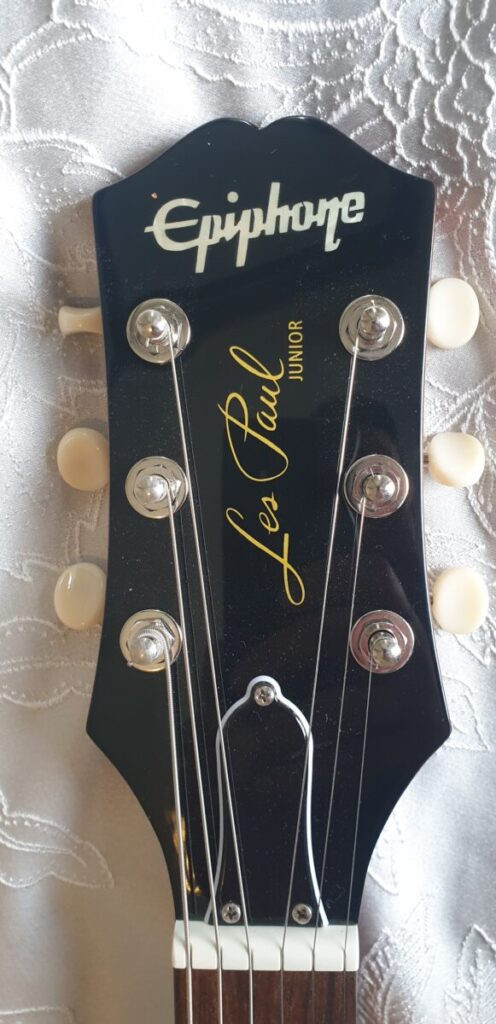 Close-up of Epiphone Les Paul Junior headstock
Close-up of Epiphone Les Paul Junior headstock
The newly designed headstock, a throwback to Epiphone’s golden era, was a definite highlight. This vintage-inspired touch added a significant dose of visual appeal, suggesting attention to detail in design, even if initial setup and feel left something to be desired.
Build Quality: A Mixed Bag?
Initial impressions of the Epiphone Les Paul Junior’s build quality were, unfortunately, underwhelming. While the specifications promised quality hardware and materials, the execution in terms of fit and finish seemed to fall short, particularly when compared to other guitars in a similar price range.
Fit and Finish Concerns
Placed amongst a wall of Fender and Squier guitars, the Epiphone Les Paul Junior struggled to compete in terms of perceived build quality. Even entry-level Squiers appeared to have a more refined fit and finish. The finish on the Junior seemed “clagged on,” lacking finesse and giving a somewhat rushed, almost DIY impression, as if assembled outside of a controlled factory environment.
The fretwork was deemed acceptable but unremarkable. The high action raised concerns, potentially masking issues with fret leveling or other neck-related problems. A proper setup, including action adjustment, would be necessary for a thorough evaluation of fretwork and overall neck condition. Compared to a previous Epiphone purchase, the highly regarded ES-335 PRO, the Les Paul Junior’s initial build quality seemed disappointing.
Sound Assessment in the Shop
Despite the concerns about playability and build quality, the core appeal of a Les Paul Junior lies in its raw, unadulterated sound. Expectations were set for that classic Les Paul “bark” – a gritty, powerful tone capable of cutting through a mix. However, the initial sonic experience proved to be less inspiring than hoped.
Tone Expectations vs. Reality
While the Epiphone Les Paul Junior did exhibit some of that characteristic Les Paul growl, it came at the expense of clarity and definition. The dynamic range and tonal versatility expected from a single P90 pickup and simple volume/tone controls seemed limited. Rolling back the volume primarily resulted in a decrease in volume, without revealing the nuanced, almost acoustic-like tones sometimes associated with P90s and thoughtful control manipulation. Similarly, reducing the tone control primarily dulled the sound, lacking the desired thickening or beefing up of the midrange. The overall sonic impression was predictable and somewhat uninspiring.
In the context of other guitars in the store, particularly Fender Player Telecasters and a Squier Classic Vibe Esquire, the Les Paul Junior’s sound felt less compelling. The Telecasters offered a comparable level of grunt but with added clarity, versatility, and responsiveness. The initial sound test left a desire for more sonic richness and dynamic range.
Value Proposition: Does it Stack Up?
Considering the overall package – initial playability, build quality impressions, and sound – the Epiphone Les Paul Junior’s value proposition was questionable in the initial guitar store assessment. While affordable, the comparison against competitors, especially Fender and Squier, cast doubt on its standing as a truly compelling value.
Price vs. Performance and Competition
Even acknowledging that a professional setup could improve playability, the out-of-the-box experience of the Epiphone Les Paul Junior fell short when pitted against similarly or even lower-priced Telecasters. While acknowledging the “apples and oranges” nature of comparing Les Pauls and Telecasters, the Telecasters seemed to deliver a more complete and immediately gratifying playing experience for the price.
Looking at higher-end Epiphone models, such as Les Paul Standards, which were only slightly more expensive, suggested potentially better value and quality within the Epiphone range itself. However, anecdotal evidence from online sources regarding quality control issues across the broader Epiphone lineup raised further concerns. The core issue seemed to be that, unlike some Fender/Squier models ready for gigging straight off the shelf, the Epiphone Les Paul Junior appeared to require additional effort and refinement to reach its full potential.
Initial Conclusion
The initial encounter with the Epiphone Les Paul Junior in a guitar store left a somewhat negative impression. Hopes for a gig-ready, simple guitar delivering a taste of classic Gibson tone were dashed by concerns about playability and a lackluster overall experience. The guitar seemed to lack the “love” or careful construction often associated with higher-quality instruments, feeling more like a collection of decent parts hastily assembled. This initial assessment concluded that the Epiphone Les Paul Junior, in its out-of-the-box state, did not fully capitalize on the potential of its classic design.
Second Chance and Changed Perspective
Despite the initial reservations, the Epiphone Les Paul Junior was given a second chance. This decision stemmed from a specific need and a shift in playing priorities. Frustration with a more complex and nuanced Stratocaster, which wasn’t quite cutting through in a band mix, led to a search for something simpler, more direct, and robust – a guitar to facilitate focused practice within a band context. The Epiphone Les Paul Junior, despite its initial shortcomings, fit the criteria of simplicity, sturdiness, and affordability, warranting a second look and a chance to prove itself in a real-world playing scenario.
Why Revisit the Les Paul Junior?
The desire for a more straightforward guitar experience drove the reconsideration of the Epiphone Les Paul Junior. The Stratocaster, while versatile, felt too intricate and demanding for the immediate need. The focus shifted towards a guitar that would encourage direct engagement with the music, without getting bogged down in tonal complexities or setup intricacies. The Les Paul Junior, with its single pickup and basic controls, promised exactly that – a direct path to raw, powerful guitar tones.
Revised First Impressions
Upon acquiring and spending time with a 2022 Epiphone Les Paul Junior, many of the initial negative impressions began to soften, and some even reversed completely. The guitar, experienced outside the critical environment of a guitar store and within the context of regular playing, revealed previously unnoticed strengths.
Neck and Gibson Feel – A New Appreciation
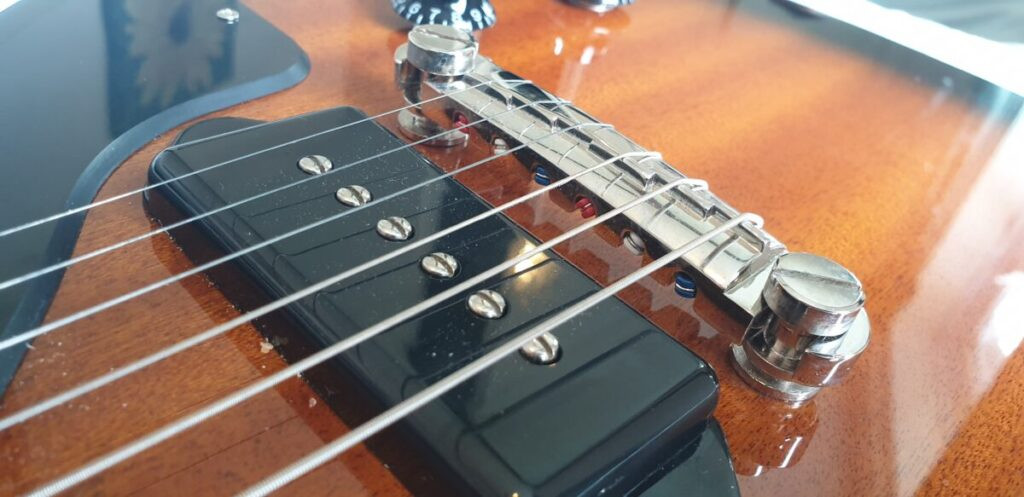 Epiphone Les Paul Junior full body shot
Epiphone Les Paul Junior full body shot
The initially criticized “huge neck” took on a new character in ownership. Instead of feeling cumbersome, it began to feel “very Gibson-like,” a significant positive. This substantial neck profile, once perceived as a drawback, now contributed to a sense of authenticity and classic Les Paul feel. In fact, the entire guitar, in hand and under regular playing conditions, felt closer to a genuine Gibson than typical Epiphone instruments, a surprising and welcome revelation.
Build Quality Revisited – Redemption?
The initial assessment of poor build quality proved to be largely inaccurate upon closer and more considered inspection of the owned Epiphone Les Paul Junior. Concerns about sloppy finish and uneven fretwork were unfounded.
Flawless Finish and Fretwork
The 2022 Epiphone Les Paul Junior exhibited a “flawlessly finished instrument for the money.” The finish was well-applied and consistent, dispelling the earlier “garden shed” assembly impression. Fears of uneven frets were also put to rest as the action was successfully lowered to a very playable 1.2mm at the 12th fret without any buzzing or dead spots. While the frets had a slightly scratchy feel initially, this was a minor issue easily addressed with minimal fret polishing using steel wool or micromesh. The overall build quality now appeared to be on par with, if not exceeding, the previously praised Epiphone ES-335 PRO.
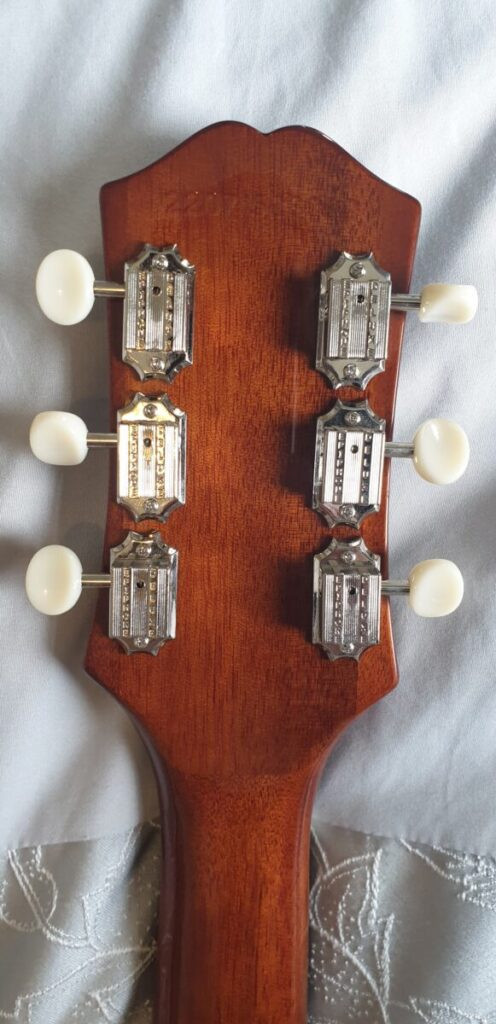 Close up of Epiphone Les Paul Junior tuners
Close up of Epiphone Les Paul Junior tuners
The Epiphone Deluxe tuners also earned praise for their stability and refined appearance, contributing to the guitar’s overall solid and dependable feel. Tuning stability proved to be excellent, further reinforcing the positive reassessment of build quality.
Playability in Long-Term Use
While build quality concerns were alleviated, the initial impression of slightly stiff playability persisted, even after optimizing the action. Compared to guitars like a Fender Player Stratocaster, the Epiphone Les Paul Junior still felt less fluid and effortless to play.
Stiffness and Bridge Design
The perceived stiffness in playability is theorized to be related to the one-piece wrap-around bridge design. The sharp break angle of the strings over the back of the bridge, compared to the more gradual angle over individual saddles on a Stratocaster, may contribute to increased string tension and a slightly less slinky feel. Regardless of the exact cause, the Epiphone Les Paul Junior, while playable and enjoyable, doesn’t quite match the effortless playability of a Strat or Les Pauls equipped with a stop tailpiece.
Sound Quality Re-evaluated – P90 in Action
The initial dismissal of the Epiphone Les Paul Junior’s sound as “dull” and “predictable” was also revised upon extended use and exploration. In a band context and through different amplification, the guitar’s sonic capabilities came to life.
Les Paul Tone Achieved
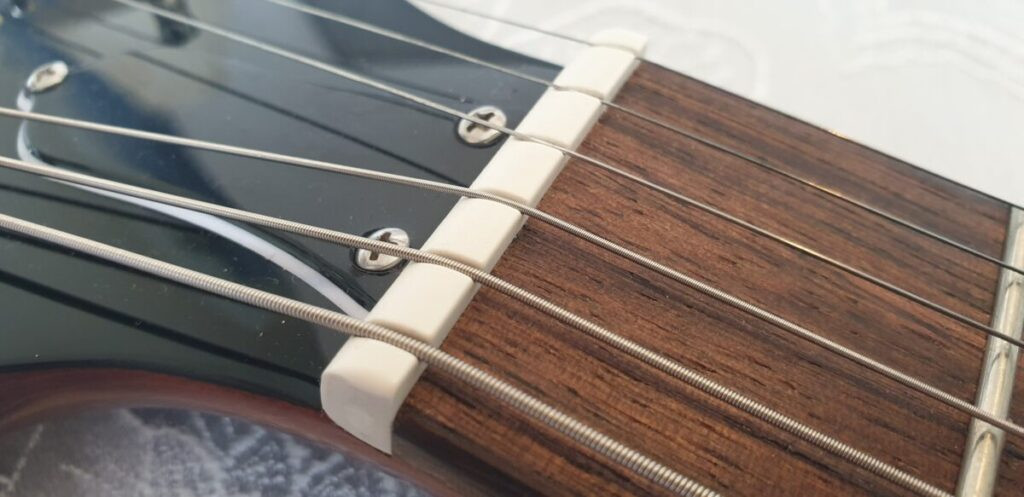 Epiphone Les Paul Junior playing close up
Epiphone Les Paul Junior playing close up
The Epiphone Les Paul Junior undeniably delivers authentic Les Paul tones. While perhaps not excelling in pristine clean sounds, it truly shines when overdriven, producing a powerful and articulate rock tone capable of holding its own against high-end guitars. The P90 pickup, initially perceived as lacking versatility, reveals its chameleon-like nature in practice. It can cover a wide range of sonic territory, although it inherently represents a compromise. While it can clean up adequately, it doesn’t achieve the sparkling cleans of a Stratocaster. And while it sings beautifully with overdrive, it doesn’t quite reach the full-bodied sustain of a humbucker-equipped Les Paul, nor does it inherently cancel hum like a humbucker.
The fabled volume and tone control manipulation on Les Paul Juniors, initially deemed a “gimmick,” remains somewhat underwhelming. While volume and tone knobs function as expected, reducing volume and treble, they don’t unlock any particularly unique or hidden sonic textures beyond what’s achievable on most guitars with similar controls. Ultimately, the Epiphone Les Paul Junior is a fantastic sounding overdriven guitar, prioritizing raw power and classic rock tones over extreme versatility.
Value for Money – Final Verdict
The long-term ownership experience significantly elevates the Epiphone Les Paul Junior’s value proposition. For its affordable price, it offers a playing experience and sonic character remarkably close to a Gibson Les Paul, albeit with necessary concessions to meet the price point.
Gibson Feel at a Fraction of the Cost
For a fraction of the cost of a Gibson Les Paul Junior, the Epiphone model provides a surprisingly similar feel and a very convincing Les Paul tone. The compromises – including a top and back veneer, a 3-piece neck, an Indian Laurel fingerboard, and a poly finish – are reasonable and do not drastically detract from the overall experience. In fact, certain features, like the Graph Tech nut, plug-in pickup connector, and shallower neck angle, could even be considered improvements or modernizations compared to vintage-spec Gibsons.
The 2022 Epiphone Les Paul Junior emerges as a seriously well-constructed, well-specified, enjoyable to play, and great-sounding guitar, especially considering its price point. The initial negative impressions were largely overturned by the positive ownership experience. Ultimately, the Epiphone Les Paul Junior is an excellent value proposition, particularly for players seeking a raw, rock-oriented guitar with authentic Les Paul character without the premium price tag. It’s a compelling choice, arguably surpassing Squier guitars in overall appeal, for those prioritizing Les Paul tone and feel, even if pristine clean tones aren’t the primary objective.

